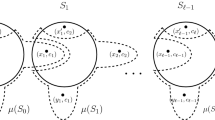Abstract
We consider the problem of finding a maximum-weight complementary basis of anm × 2m matrix. The problem arises naturally, for example, when a complementary set of columns is proposed as an initial basis for a “warm start” of Lemke's algorithm, but the set of columns is rank-deficient. We show that the problem is a special case of the problem of finding a maximum-weight common base of two matroids. Furthermore, we show how to efficiently implement an algorithm for the general problem in the present context. Finally, we give computational results demonstrating the practicality of our algorithm in a typical application.
Similar content being viewed by others
References
C. Brezovec, G. Cornuejols and F. Glover, “Two algorithms for weighted matroid intersection,”Mathematical Programming 36 (1986) 39–53.
C. Brezovec, G. Cornuejols and F. Glover, “A matroid algorithm and its application to the efficient solution of two optimization problems on graphs,”Mathematical Programming (Series B) 42 (1988) 471–487.
P.M. Camerini and H.W. Hamacher, “Intersection of two matroids: (condensed) border graphs and ranking,”SIAM Journal of Discrete Mathematics 2 (1989) 16–27.
J. Edmonds, “Submodular functions, matroids and certain polyhedra,” in: R. Guy, ed.,Combinatorial Structures and Their Applications, Proceedings of the Calgary International Conference (Gordon and Breach, New York, 1970) pp. 69–87.
J. Edmonds, “Matroid intersection,”Annals of Discrete Mathematics 4 (1979) 39–49.
A. Frank, “A weighted matroid intersection algorithm,”Journal of Algorithms 2 (1981) 328–336.
P.E. Gill, W. Murray, M.A. Saunders and M.H. Wright, “Maintaining LU factors of a general sparse matrix,” Technical Report SOL 86-8, Department of Operations Research, Stanford University (Stanford, CA, 1986).
P.T. Harker and J.-S. Pang, “Finite-dimensional variational inequality and nonlinear complementarity problems: a survey of theory, algorithms and applications,” Department of Decision Sciences, The Wharton School, University of Pennsylvania (Philadelphia, PA, 1987).
M. Iri, “Applications of matroid theory,” in: A. Bachem, M. Grötschel and B. Korte, eds.,Mathematical Programming: The State of the Art, Bonn 1982 (Springer, Berlin, 1983) pp. 158–201.
M. Iri and N. Tomizawa, “An algorithm for finding an optimum independent assignment,”Journal of the Operations Research Society of Japan 19 (1976) 32–57.
N. Karmarkar, “A new polynomial time algorithm for linear programming,”Combinatorica 4 (1984) 373–395.
M. Kojima, S. Mizuno and A. Yoshise, “A polynomial-time algorithm for a class of linear complementarity problems,”Mathematical Programming 44 (1989) 1–26.
E. L. Lawler,Combinatorial Optimization: Networks and Matroids (Holt, Rinehart and Winston, New York, 1976).
E.L. Lawler, “Optimal matroid intersection,” in: R. Guy, ed.,Combinatorial Structures and Their Applications, Proceedings of the Calgary International Conference (Gordon and Breach, New York, 1970) p. 233.
E.L. Lawler, “Matroid intersection algorithms,”Mathematical Programming 9 (1975) 31–56.
J. Lee and J. Ryan, “Matroid applications and algorithms,” to appear in:ORSA Journal on Computing 4 (1991).
C.E. Lemke, “On complementary pivot theory,” in: G.B. Dantzig and A.F. Veinott Jr., eds.,Mathematics of the Decision Sciences, Part I (American Mathematical Society, Providence, RI, 1968) pp. 95–114.
L. Mathiesen, “Computation of economic equilibria by a sequence of linear complementarity problems,”Mathematical Programming Study 23 (1985) 144–162.
L. Mathiesen, “Computation experience in solving equilibrium models by a sequence of linear complementarity problems,”Operations Research 33 (1985) 1225–1250.
R.C. Monteiro and I. Adler, “Interior path following primal—dual algorithms. Part I: Linear programming,”Mathematical Programming 44 (1989) 27–41.
R.C. Monteir and I. Adler, “Interior path following primal—dual algorithms. Part II: Convex quadratic programming,”Mathematical Programming 44 (1989) 43–66.
K.G. Murty,Linear Complementarity, Linear and Nonlinear Programming (Heldermann, Berlin, 1988).
J.B. Orlin and J. Vande Vate, “On a ‘primal’ matroid intersection algorithm,” Sloan School Technical Report, MIT (Cambridge, MA, 1984).
T.F. Rutherford, “Applied general equilibrium modeling,” Ph.D. Dissertation, Department of Operations Research, Stanford University (Stanford, CA, 1986).
T.F. Rutherford, “General equilibrium modeling withMps/ge,” Technical Report, Department of Economics, University of Western Ontario (London, Ont., 1988).
Author information
Authors and Affiliations
Additional information
Supported by the Canadian Natural Science and Engineering Research Council.
Rights and permissions
About this article
Cite this article
Anstreicher, K.M., Lee, J. & Rutherford, T.F. Crashing a maximum-weight complementary basis. Mathematical Programming 54, 281–294 (1992). https://doi.org/10.1007/BF01586055
Received:
Revised:
Issue Date:
DOI: https://doi.org/10.1007/BF01586055




